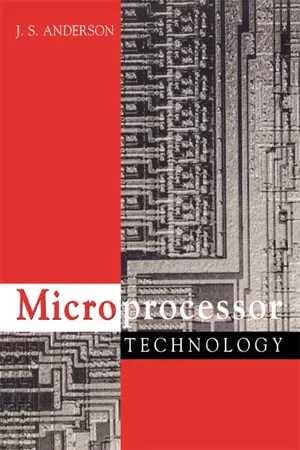
- 240 pages
- English
- ePUB (mobile friendly)
- Available on iOS & Android
Microprocessor Technology
About this book
'Microprocessor Technology' provides a complete introduction to the subject of microprocessor technology using the Z80 and 6502 processors. An emphasis on fault-finding and repair makes this an ideal text for servicing courses including City & Guilds 2240 in the UK, microelectronics units on BTEC National/Advanced GNVQ and City & Guilds 7261 Microprocessor Technology. It will also provide a refresher course for those on 'bridging' and micro appreciation courses where a measure of comparative studies is required. Clear and concise explanations are supported by worked examples, tutorials, long answer questions and assignments giving students the opportunity to test their knowledge as they progress through the course as well as providing an essential revision tool in the run-up to exams.
Frequently asked questions
- Essential is ideal for learners and professionals who enjoy exploring a wide range of subjects. Access the Essential Library with 800,000+ trusted titles and best-sellers across business, personal growth, and the humanities. Includes unlimited reading time and Standard Read Aloud voice.
- Complete: Perfect for advanced learners and researchers needing full, unrestricted access. Unlock 1.4M+ books across hundreds of subjects, including academic and specialized titles. The Complete Plan also includes advanced features like Premium Read Aloud and Research Assistant.
Please note we cannot support devices running on iOS 13 and Android 7 or earlier. Learn more about using the app.
Information
Chapter 1
The microelectronic system
Introduction


The silicon chip
The hardware
Table of contents
- Front Cover
- Half Title
- Dedication
- Title Page
- Copyright
- Contents
- Preface
- Acknowledgements
- 1 The microelectronic system
- 2 Binary maths and number systems
- 3 The CPU and a microprocessor system
- 4 Memory maps and memory organisation
- 5 Machine code programming
- 6 Machine code instructions and addressing modes
- 7 The fetch-execute sequence
- 8 Timing diagrams
- 9 Organisation and use of the stack
- 10 The flag register
- 11 Debugging programs
- 12 The input/output (I/O) ports
- 13 Writing software – more advanced techniques
- 14 Computer interfacing
- 15 Integrated circuits and logic families
- 16 Implementation of memory systems
- 17 Programmable I/O devices
- 18 Fault-finding in microprocessor systems
- Appendix I Answers
- Appendix II Selected IC pin-outs
- Appendix III Glossary
- Appendix IV Logic symbols with their truth tables
- Appendix V Z80 instruction set
- Appendix VI 6502 instruction set
- Appendix VII Some Z80 and 6502 instruction equivalents
- Index